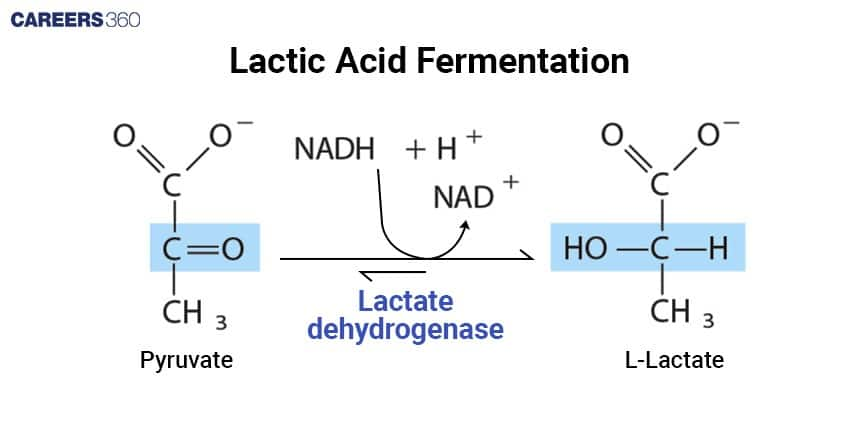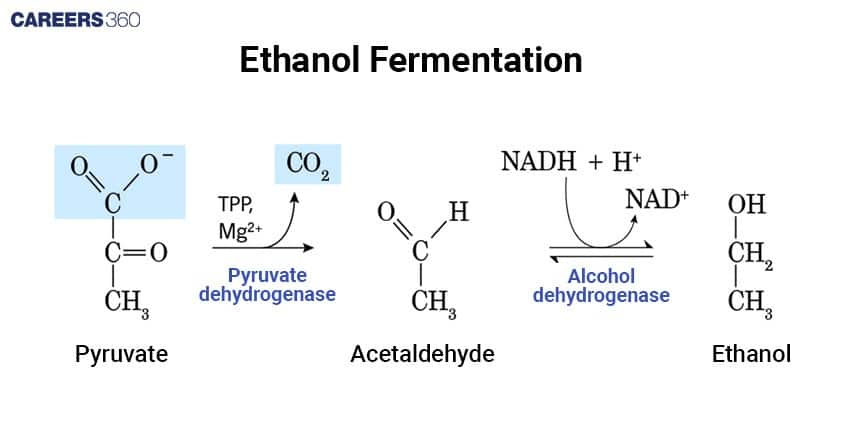Fermentation: Anaerobic Respiration: Definition, Equation, Types
Fermentation is an anaerobic pathway that breaks down glucose to regenerate NAD⁺, allowing glycolysis to continue even in the absence of oxygen. It produces lactic acid, ethanol, CO₂, or acetic acid depending on the organism and enzymes involved. Fermentation is key for muscle metabolism, food industries, and NEET examination content on anaerobic respiration.
This Story also Contains
- What Is Fermentation?
- Why Fermentation Is Needed
- Types Of Fermentation
- Fermentation vs Anaerobic Respiration
- Industrial Applications of Fermentation
- Fermentation NEET MCQs (With Answers & Explanations)

What Is Fermentation?
Fermentation is an anaerobic process in which energy from glucose can be released if oxygen is not available. This process mainly takes place in the yeast cells and bacteria and the muscle cells of animals. It is an anaerobic pathway of glucose breakdown to yield energy. The cellular respiration process, both aerobic and anaerobic, commences with glycolysis. Glycolysis is the pathway in which glucose gets converted into pyruvic acid, a three-carbon compound.
This molecule is further oxidised in the mitochondria only when oxygen is present. However, in anaerobic conditions, there is no possibility of oxidation in the mitochondria, so fermentation provides an alternative route for pyruvate metabolism. This pathway allows cells to re-generate NAD+, through which glycolysis can proceed to continue ATP production when O2 is in short supply.
Why Fermentation Is Needed
The process of fermentation is needed in:
The Core Problem Under Anaerobic Conditions
NAD+ becomes unavailable because NADH cannot donate any electrons to electron transport chain (ETC).
If NAD+ is unavailable, the glycolysis pathway stops.
Fermentation Solves the Problem
It converts the pyruvic acid into the reduced product, i.e., either ethanol or lactate.
It reoxidizes NADH to NAD+.
It maintains the production of ATP via the glycolysis pathway.
Types Of Fermentation
There are three main types of fermentation based on the end products formed:
Lactic Acid Fermentation
In lactic acid fermentation, glucose or any other types of sugar are converted to lactic acid by some bacteria and yeast. This process, however, has a higher occurrence in situations of extensive exercise where the muscle cells require more oxygen to supply energy. Lactic acid builds up in the muscles after exercises and causes them to feel tired and sore, as generally happens a day or two after doing heavy exercise.

Alcohol Fermentation
Alcohol fermentation is a process in which pyruvate is converted into ethanol and carbon dioxide. The application is in the manufacture of ethyl alcohol or wine and beer brewing. The process involves mainly yeast cells, especially Saccharomyces cerevisiae. The conversion of pyruvate into ethanol is through the activity of two enzymes: pyruvic acid decarboxylase and alcohol dehydrogenase.

Acetic Acid Fermentation
Acetic acid fermentation refers to the process of fermentation whereby starch and sugars present in grains and fruits get converted into vinegar and condiments. Apple cider vinegar is one such example. This type of fermentation is significant in the industries of food as it leads to a great deal of variety of fermented products.

Fermentation vs Anaerobic Respiration
Anaerobic respiration is cellular respiration performed without oxygen. One typical pathway for anaerobic respiration performed by various prokaryotes and unicellular eukaryotes is fermentation.
Feature | Fermentation | Anaerobic Respiration |
Final electron acceptor | Organic molecule | Inorganic molecule |
ATP yield | 2 ATP | Higher |
Presence of ATP | No | Yes |
End products | Ethanol / Lactate / Acetic acid | Depends on the organism |
Location | Cytoplasm + Mitochondria |
Industrial Applications of Fermentation
The process of fermentation in used in various industrial applications:
It is used in alcohol industries for making beer and wine.
It is used to make dairy products like cheeses, curd and yogurt.
It is also used in the pharmaceutical companies for making antibiotics.
Other food items like vinegar, bread and fermented juices are also produced.
Fermentation NEET MCQs (With Answers & Explanations)
Important topics for NEET are:
- Types pf Fermentation
- Fermentation vs Anaerobic respiration
Practice Questions for NEET
Q1. The most abundant prokaryotes helpful to humans in making curd from milk and in production of antibiotics are the ones categorised as:
Cynabacteria
Archaebacteria
Chemosynthetic autotrophs
Heterotrophic bacteria
Correct answer: 4) Heterotrophic bacteria
Explanation:
The most abundant prokaryotes helpful to humans in making curd from milk and in the production of antibiotics are heterotrophic bacteria. Heterotrophic bacteria are useful to humans in a variety of ways. But they are also known to cause various harmful diseases.
Hence, the correct answer is option 4) Heterotrophic bacteria.
Q2. What amount of energy is released from glucose during lactic acid fermentation?
More than 18%
About 10%
Less than 7%
Approximately 15%
Correct answer: 3) Less than 7%
Explanation:
Lactic acid fermentation is an anaerobic (oxygen-free) process that converts glucose to lactic acid and ATP, which is the energy source. During aerobic respiration, 38 ATP are released per glucose molecule. During lactic acid fermentation, less than 7 % of the total energy in glucose During alcoholic fermentation, 2 ATP is released per glucose molecule.
Hence, the correct answer is option 3) Less than 7%.
Q3. What type of reaction is lactic acid fermentation?
Oxidation
Reduction
Hydrolysis
Dehydration
Correct answer: 2) Reduction
Explanation:
Lactic acid fermentation is a critical anaerobic process that transpires in the absence of oxygen, wherein pyruvate, a glycolysis byproduct, is transformed into lactic acid or lactate. This biochemical event exemplifies a redox reaction, during which NADH is oxidized back to NAD⁺, a pivotal step because it facilitates the persistent production of ATP via glycolysis despite oxygen scarcity. The essential chemical transformation is succinctly represented as:
Pyruvate + NADH ⇌ Lactic acid + NAD⁺
This mechanism is frequently observed in muscle cells during rigorous physical activities when the oxygen supply is inadequate to meet the cell's energy demands. Additionally, certain microbes, such as lactic acid bacteria, also exhibit this fermentation pathway. The significance of regenerating NAD⁺ lies in its role as an electron acceptor in glycolysis, thus ensuring the continuation of the energy-yielding process even in anaerobic conditions. Consequently, this process is vital for organisms that encounter environments lacking in oxygen, such as muscle cells during intense exercise and the aforementioned bacterial species.
Hence, the correct answer is option 3) Reduction.
Also Read:
Frequently Asked Questions (FAQs)
During intense exercise, lactic acid fermentation causes lactic acid buildup in muscles that can lead to aching and fatigue.
In all, during fermentation two ATP molecules per glucose molecule are produced, much fewer than in aerobic respiration.
Fermentation is an anaerobic process in which cells release energy from glucose that does not require the presence of oxygen.
The major types of fermentation include lactic acid fermentation, alcoholic fermentation, and acetic acid fermentation.